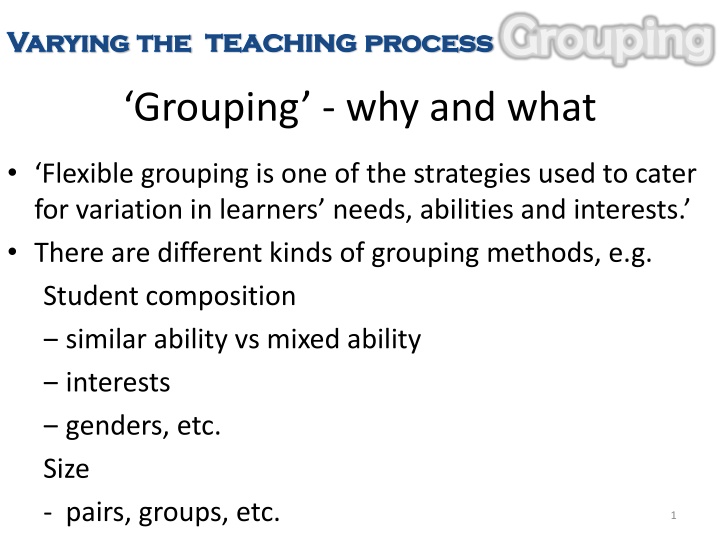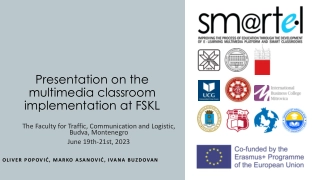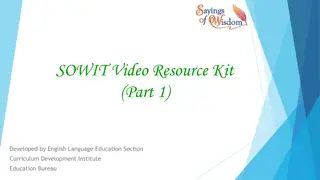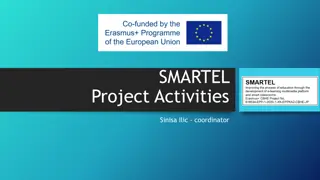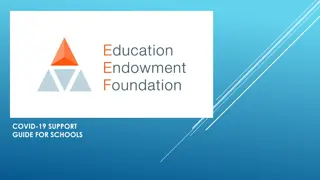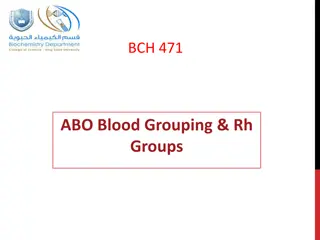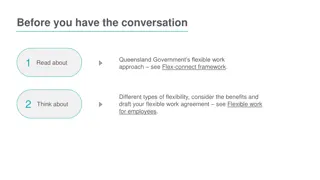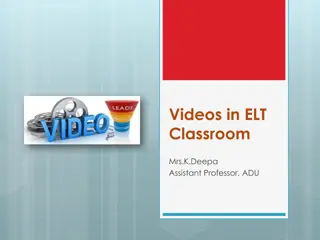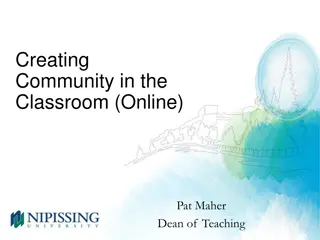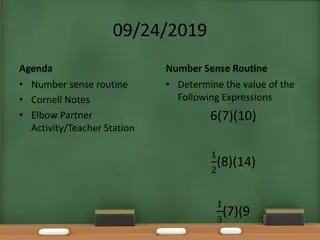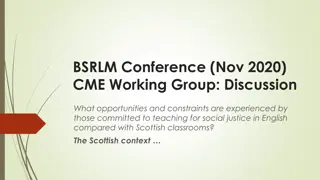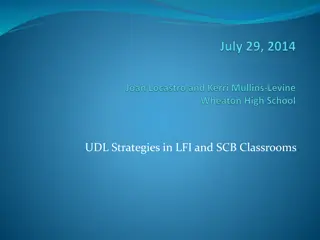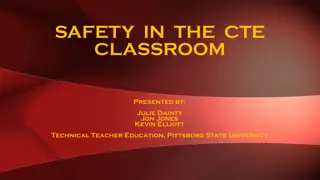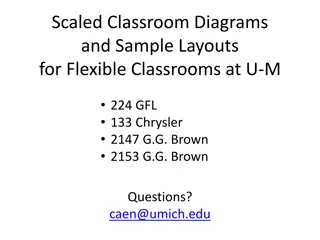Enhancing English Classrooms through Flexible Grouping Strategies
Strategies for grouping students in English classrooms are explored, focusing on the benefits of flexible grouping to cater to diverse learner needs. Various grouping methods, such as mixed ability and similar ability groupings, are discussed alongside a lesson example on exploring different aspects of Hong Kong through vocabulary building, reading, writing, and speaking activities. The rationale behind different grouping methods and varying demands for different groups are also highlighted, emphasizing the importance of co-operative learning structures in optimizing student engagement and participation.
Download Presentation

Please find below an Image/Link to download the presentation.
The content on the website is provided AS IS for your information and personal use only. It may not be sold, licensed, or shared on other websites without obtaining consent from the author.If you encounter any issues during the download, it is possible that the publisher has removed the file from their server.
You are allowed to download the files provided on this website for personal or commercial use, subject to the condition that they are used lawfully. All files are the property of their respective owners.
The content on the website is provided AS IS for your information and personal use only. It may not be sold, licensed, or shared on other websites without obtaining consent from the author.
E N D
Presentation Transcript
Grouping Varying the teaching process Grouping - why and what Flexible grouping is one of the strategies used to cater for variation in learners needs, abilities and interests. There are different kinds of grouping methods, e.g. Student composition similar ability vs mixed ability interests genders, etc. Size - pairs, groups, etc. 1
Grouping - how How can grouping be done in an English classroom? Let s look at an example. Theme: Hong Kong Now and Then Objectives: 1. To talk about different aspects of Hong Kong now and then with different words and phrases 2. To revisit past tense to talk about things in old Hong Kong and present tense to talk about Hong Kong today 3. To learn about different aspects of old Hong Kong Main task: Write an article about different aspects of old Hong Kong 2
A brief lesson flow Vocabulary building: Learn words/ phrases about Hong Kong now and then Class brainstorm and guessing game Language: Revise present and past tense 1 Reading input: Read texts and share knowledge of different aspects of Hong Kong now and then Group jigsaw reading activity 2 Writing activity: Write sentences about different aspects of old Hong Kong Pair writing 3 Speaking activity: Present sentences about different aspects of old Hong Kong Pair speaking 4 Main writing task: Write an article about different aspects of old Hong Kong Individual writing 5 3
Group jigsaw reading task Phase one - similar ability grouping Phase two - mixed ability grouping Less proficient group More proficient group Less proficient member More proficient member Average group Average group Average member Average member 4
What is the rationale behind different grouping methods? Level of support Level of interaction Level of participation 5
Varying demands for different groups Assigning different aspects of a topic Way of life Entertainment Housing Transportation Task Length requirement Support Using co-operative learning structures 6
Use co-operative learning structures Assigning roles in a writing group Numbered Heads Tense police Punctuation guard Vocabulary builder Idea generator Round robin Jigsaw reading Assigning roles Think-pair-share 7
It is always good to put students of It is always good to put students of mixed abilities in the same group. mixed abilities in the same group. Do you agree? When grouping learners, the teacher should make decisions relating to the ability (similar or mixed ability grouping) and the size of groups according to the purposes and requirements of tasks. 8
Questioning Questioning - why Teachers can collect a lot of information about learners knowledge and skills in the language, as well as their values and attitudes towards specific topics or learning in general, through appropriate use of a variety of question types. Questions can be content-centred that go beyond the surface meaning. Open-ended questions that ask learners to analyze, synthesize or evaluate information are more useful than closed ones. 9
What kind of questions to ask Assigning questions at different levels of complexity Bloom's taxonomy of thinking skills Knowledge Comprehension Application Analysis Synthesis Evaluation 10
Bloom's taxonomy of thinking skills (1956) Revised framework (2001) define, list, recall, repeat, state Knowledge Remember classify, describe, summarise, explain Understand Comprehension Application Apply apply, problem-solve compare, contrast, analyse Analysis Analyze Synthesis Evaluate judge, evaluate, criticize Evaluation Create construct, create, design Verb Noun 11
The Three Little Pigs Knowledge - What do the little pigs want to build? define, list, recall, repeat, state classify, describe, summarise, explain Comprehension - Why is the house of the first little pig blown down so easily? apply, problem-solve Application - How would you protect yourselves from the wolf if you were the little pigs? 12
compare, contrast, analyse What are the differences among the three little pigs? Analysis - Evaluation - judge, evaluate, criticize The third little pig kills the big bad wolf. Do you think this is the right thing to do? Why/ why not? construct, create, design Can you rewrite the ending of the story to promote friendship? Synthesis - 13
1. If you were Cinderella and you wanted to join the party, what would you do? Knowledge 2. Who are the characters in the story of Cinderella? Comprehension 3. Do you think Cinderella s stepmother and sisters should ask Cinderella to do all the housework? Why? Application Analysis 4. Can you think of a new way to help Cinderella? Evaluation 5. Why does Cinderella have to leave the party before midnight? Synthesis 6. Compare Cinderella and her step sisters. 14
Scaffolding [Scaffolding] has been praised for its ability to engage most learners because they are constantly building on prior knowledge and forming associations between new information & concepts This type of instruction minimizes failure, which decreases frustration, especially for students with special learning needs. (Heather Coffey) 15
An example of scaffolding (P.4) Theme: Attractions in HK Objectives: talk about different attractions in HK use present tense to talk about things that can be done in the above places. learn how to write an email Main task: write an email to tell the e-pal about a 1-day itinerary in HK (Final Task) 16
Procedures (with scaffolding): Pre-writing stage learn names of different attractions in HK (words & phrases) learn and write about the activities that can be done in these places (sentences) construct a paragraph(s) about these places in a class based activity with the help of a graphic organizer/ relevant websites generate more ideas (paragraphs) While-writing stage conduct group writing to consolidate what they try in the pre-writing stage Individual writing 17
Scaffolding strategies Individual writing Paragraph writing Examples Planning tools/ organisers Group/pair writing Sentence making Class writing Vocabulary building Brainstorming activities Ideas & Organisation Language Confidence 18
My students all differ in their motivation level & intelligences. And they always forget what is taught. How can I tailor my instruction to all those needs? Make learning tasks/activities more stimulating and enjoyable 19
Active learning Active learning: Why & What Active learning is a model of instruction that focuses the responsibility for learning on learners. It engages students in two aspects doing things and thinking about the things they are doing (Bonwell and Eison, 1991). Enlisting students as active participants can maintain learning motivation (Dornyei 2001) 20
Active learning Use multi-sensory teaching Use multiple intelligence approach Use games / hands-on activities Increase mental and/or bodily involvement 21
Use multi-sensory teaching Use audio 22
Colour coding Frosty has a sharp/ long nose two round/ small eyes a big mouth 23
Multi-media resources and put their hearts and souls into decorating it. They loved it so Watch a music video called Frosty the Snowman 24
Chips have salt in them. They are crispy and salty. Use multi-sensory experiences A marshmallow has jam in it. It is sweet and soft. An Oreo biscuit has cream in it. It is crunchy and sweet. You will be given a kind of food to try. Is it sweet or bitter? Is it hard or soft? Is it crunchy or chewy (or both!) What is in it? (nuts, marshmallow, toffee etc. Give it a mark out of ten Write its name on the paper 25
Use multi-sensory experiences A visit to Tai O Smell What did you smell? salty fish shrimp paste curry fish balls Touch What did you touch? stilt houses sampan bridge Sight What did you see? trees people sampans salted fish Sunset waterway different (kinds of) seafood Hear What did you hear? Tai O people talking /selling seagulls Taste What did you taste? tea dumplings fish balls Sweet beancurd dessert 26
Theory of Multiple Intelligences Use multiple intelligence approach Verbal/ Linguistic Logical/ Mathematical Musical/ Rhythmic Intra- personal Bodily/ kinesthetic Multiple Intelligences Inter- personal Visual/ Spatial Naturalistic 27 Howard Gardner 1993
How to tap into students multiple intelligences in class Task: write a letter to a friend and tell him how you spent your picnic day Pre-tasks tapping into different intelligences: brainstorm and discuss what students can do on the picnic day sequence events that happened sing a song about picnics Musical/ rhythmic Verbal/ linguistic Logical/ Mathematical 28
show photos taken on a picnic day to help students generate ideas play Crocodile vocabulary about picnics note down observations surroundings on the picnic day discuss in groups what they can/ cannot do on the picnic day edit their own writing Visual/ spatial Bodily/ kinesthetic Bench to revise of the Naturalistic Inter-personal Intra-personal 29
How to play Crocodile Bench 1. Students form 3 groups 2. Students queue up on a bench 3. Each student gets a word card 4. Teacher reads aloud a word related to picnics , e.g. picnic food 5. Students with that food card move to the front. 6. The quickest one who is able to pronounce the word correctly is the winner 30
Multiple Intelligences in action (1) P.4 Average class (35 students) Usual practice: Pre-teaching necessary vocab at pre-reading stage Word Card Action Game Extent of mental involvement No. of sensory learning preferences used Amount of S-S interaction 31
Multiple Intelligences in action (2) P.3 Average class 15-19 students: Extroverted, talkative, active, weak in spelling Running Dictation Extent of mental involvement No. of sensory learning preferences used Amount of S-S interaction 32
